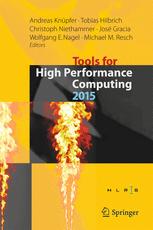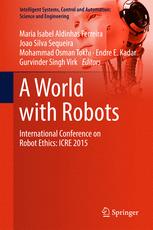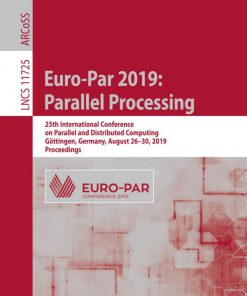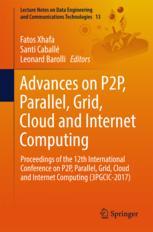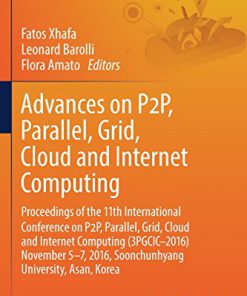Cable Driven Parallel Robots Proceedings of the Second International Conference on Cable Driven Parallel Robots 1st Edition by Andreas Pott, Tobias Bruckmann 3319094892 9783319094892
$50.00 Original price was: $50.00.$25.00Current price is: $25.00.
Cable Driven Parallel Robots Proceedings of the Second International Conference on Cable Driven Parallel Robots 1st Edition by Andreas Pott, Tobias Bruckmann – Ebook PDF Instant Download/DeliveryISBN: 3319094892, 9783319094892
Full download Cable Driven Parallel Robots Proceedings of the Second International Conference on Cable Driven Parallel Robots 1st Edition after payment.
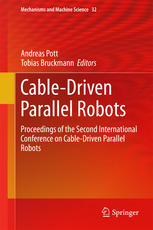
Product details:
ISBN-10 : 3319094892
ISBN-13 : 9783319094892
Author: Andreas Pott, Tobias Bruckmann
This volume presents the outcome of the second forum to cable-driven parallel robots, bringing the cable robot community together. It shows the new ideas of the active researchers developing cable-driven robots. The book presents the state of the art, including both summarizing contributions as well as latest research and future options. The book cover all topics which are essential for cable-driven robots: Classification Kinematics, Workspace and Singularity Analysis Statics and Dynamics Cable Modeling Control and Calibration Design Methodology Hardware Development Experimental Evaluation Prototypes, Application Reports and new Application concepts.
Cable Driven Parallel Robots Proceedings of the Second International Conference on Cable Driven Parallel Robots 1st Table of contents:
Part I Modeling
1 The Forward Kinematics of Cable-Driven Parallel Robots with Sagging Cables
1 Introduction
2 Problem Statement
2.1 Cable Model
2.2 The FK Problem
3 Solving the FK
3.1 Determining Exact Solutions
3.2 Heuristics
3.3 Implementation
4 Example
5 Conclusions
References
2 An Elastic Cable Model for Cable-Driven Parallel Robots Including Hysteresis Effects
1 Introduction
2 Robot and Cable Elasticity Model
3 Design of Experiments and Parameter Identification
4 Experimental Results
5 Conclusion and Outlook
References
3 On the Improvement of Cable Collision Detection Algorithms
1 Introduction
2 Interferences Between Cables and Cables
3 Interferences Between Cables and CDPR Mobile Platform
3.1 Method 1
3.2 Method 2
4 Verification of Collision Free Condition for a Given Workspace
5 Simulation
6 Conclusion
References
4 Workspace Analysis of Redundant Cable-Suspended Parallel Robots
1 Introduction
2 The Interval-Analysis Procedure
2.1 Introduction to Interval Analysis
2.2 Geometrico-Static Model for a CSPR with 6 Cables
2.3 Description of the Algorithm
3 Examples and Discussion of Results
3.1 Straight-Line Trajectories
3.2 Circular Trajectory
3.3 Algorithm Performances
4 Conclusions
References
5 On the Static Stiffness of Incompletely Restrained Cable-Driven Robot
1 Introduction
2 Formulation of Static Stiffness
2.1 Configuration
2.2 Configuration Stiffness
2.3 Deformation stiffness
3 Numerical Examples
3.1 Redundantly Restrained Cable Robot
3.2 Incompletely Restrained Cable Robot
4 Static Stiffness and First Design
5 Conclusions
References
6 Simulation and Control with XDE and Matlab/Simulink of a Cable-Driven Parallel Robot (CoGiRo)
1 Introduction
2 Principle of Modeling in XDE Simulation Environment
2.1 Winch Modeling
2.2 Pulley Modeling
2.3 Cable Fastening Modeling
2.4 Platform Modeling
2.5 Cable Modeling
2.6 Complete CoGiRo Robot Scene
3 Interface with Matlab/Simulink Controller
4 Simulation Discussion
4.1 Simulation Interesting Features
4.2 Simulation Issues and Alternatives
4.3 Future Work
5 Conclusions
References
Part II Accuracy
7 Presentation of Experimental Results on Stability of a 3 DOF 4-Cable-Driven Parallel Robot Witho
1 Introduction
2 Related Work
3 Model of the Cable Robot
3.1 Stiffness
3.2 Deflection Under Transverse Force
3.3 Natural Frequency
4 Experimental Results
4.1 Experiment Setup
4.2 Results
4.3 Discussion
5 Conclusion
References
8 Experimental Determination of the Accuracy of a Three-Dof Cable-Suspended Parallel Robot Perform
1 Introduction
2 Kinematic and Dynamic Modelling
3 Trajectory Planning
4 Experimental Determination of the Accuracy
4.1 Horizontal Straight-Line Trajectory
4.2 Circular Trajectory in a Vertical Plane
4.3 Circular Trajectory in a Horizontal Plane
5 Conclusion
References
9 Efficient Calibration of Cable-Driven Parallel Robots with Variable Structure
1 Introductionaut]SurdilovicDragoljub@Surdilovic, Dragoljubaut]RadojicicJelena@Radojicic, Jelenaaut]2 Kinematic Analysis
3 Wire-Robot Jacobian and Its Time-derivative
4 Parameter Sensitivity Model
5 Calibration Procedure
6 Conclusion
References
Part IIIControl
10 Robust Internal Force-Based Impedance Control for Cable-Driven Parallel Robots
1 Introduction
2 Manipulator Dynamics
2.1 Formulation in EE Coordinates
2.2 Inverse Dynamics in EE Coordinates
3 Disturbance Observer
3.1 Motivation
3.2 Derivation of the Disturbance Observer
3.3 Passivity
4 Internal Force-Based Impedance Control
4.1 Motivation
4.2 Derivation of the Control Law
5 Experimental Results
6 Summary
References
11 Adaptive Control of KNTU Planar Cable-Driven Parallel Robot with Uncertainties in Dynamic and Kin
1 Introduction
2 Robot Dynamics and Kinematics
3 Controller Design
3.1 Adaptation of Dynamic Parameters
3.2 Adaptation of Kinematic Parameters
4 Experimental Results
4.1 KNTU Planar Cable-Driven Parallel Robot
4.2 Control Scheme
4.3 Results
5 Conclusion
References
12 Dynamic Analysis and Control of Fully-Constrained Cable Robots with Elastic Cables: Variable St
1 Introduction
2 Control of Rigid Cable Driven Parallel Robots
2.1 Control Algorithm
2.2 Stability Analysis
3 Robot with Elastic Cables
3.1 Control
3.2 Stability Analysis
4 Case Study
5 Conclusions
References
13 Adaptive Terminal Sliding Mode Control of a Redundantly-Actuated Cable-Driven Parallel Manipulat
1 Introduction
2 Kinematic and Dynamic Modeling of CDPM
2.1 Kinematic Model
2.2 Platform Dynamics
2.3 Winches Dynamics
2.4 CDPM Dynamics in Operational Space
2.5 Properties of the Dynamic Model
3 Adaptive TSM Control of CDPM
3.1 TSM Control
3.2 Non-Singular TSM Control
3.3 Adaptive TSM Control Scheme
4 Simulation Study: Control of CoGiRo
4.1 CoGiRo Prototype
4.2 Simulation Results
5 Conclusion
References
14 Haptic Interaction with a Cable-Driven Parallel Robot Using Admittance Control
1 Introduction
2 Robot Model
3 Admittance Control
3.1 Model of the Virtual System Behavior
3.2 Model of the Virtual Workspace
3.3 Simulation of the Virtual System
4 Controller Implementation
4.1 Controller Design
4.2 Implementation
5 Experimental Investigation
5.1 Feasible Bandwidth
5.2 Eigenfrequency
5.3 Operation
6 Conclusion and Outlook
References
15 A Kinematic Vision-Based Position Control of a 6-DoF Cable-Driven Parallel Robot
1 Introduction
2 System Description
2.1 INCA Robot
2.2 Bonita Motion-Capture System
3 Modelling of the 6-DoF CDPRs
3.1 Kinematics Modelling
3.2 Dynamics Modelling
4 Kinematic Vision-Based Position Control
4.1 Overview
4.2 Position Control
4.3 Tension Distribution
5 Results
5.1 Evaluation Task
5.2 Controllers Design
5.3 Obtained Performances
6 Conclusion
References
16 Analysis of a Real-Time Capable Cable Force Computation Method
1 Introduction
2 Problem Definition
2.1 Mathematical Definition
2.2 Solution Approaches
3 Improved Puncture Method
4 Analysis for a CDPR with a Threefold Redundancy
4.1 Workspace
4.2 Resulting Cable Force Distributions
4.3 Computation Time
4.4 Real-Time Control Application
5 Conclusion
References
17 First Experimental Testing of a Dynamic Minimum Tension Control (DMTC) for Cable Driven Parallel
1 Introduction
2 Dynamic Minimum Tension Control
3 Experimental Setup and Results
4 Conclusion
References
18 Modeling and Control of a Large-Span Redundant Surface Constrained Cable Robot with a Vision Sens
1 Introduction
2 Method
2.1 Model
2.2 Control
2.3 Experimental Setup
3 Results
3.1 Experimental Results
3.2 Simulation Results
4 Discussion
5 Conclusion
References
Part IV Application
19 Cable Function Analysis for the Musculoskeletal Static Workspace of a Human Shoulder
1 Introduction
2 Musculoskeletal Static Workspace of the Human Shoulder
2.1 Hill-type Muscle Model
2.2 Shoulder Workspace
3 Gravity Force Cable Function at a Pose
4 Muscle Function over the Workspace
5 Conclusion
References
20 A Reconfigurable Cable-Driven Parallel Robot for Sandblasting and Painting of Large Structures
1 Introduction
2 Context and Problem Description
3 RCDPR Kinetostatic Modeling
4 Design Procedure
4.1 Design Parameters
4.2 Configuration mathscrC1
4.3 Configuration mathscrC2
4.4 Configuration mathscrC3
4.5 Constraints
4.6 Objective Functions
4.7 Design Problem Formulation
5 Results
6 Conclusions
References
21 ARACHNIS: Analysis of Robots Actuated by Cables with Handy and Neat Interface Software
1 Introduction
2 Kinetostatic Model of a Cable-Driven Parallel Robot
3 The Capacity Margin as a Measure of the Robustness of Equilibrium
4 Tracing the Wrench-Feasible Workspace Using the Capacity Margin
5 Tracing the Interference Polygons
6 The ARACHNIS Interface
7 Case Study 1: A Planar Cable-Driven Parallel Mechanism
8 Case Study 2: A Spatial Cable-Driven Parallel Mechanism
9 Conclusions
References
22 Upper Limb Rehabilitation Using a Planar Cable-Driven Parallel Robot with Various Rehabilitation
1 Introduction
2 Mechanical Design
2.1 Design Scheme
2.2 Upper Limb Motion
2.3 Prototype and Its Size
2.4 System Communication Structure and Winches
3 Motion Analysis
3.1 Experimental Setup
3.2 Experiment Result and Discussion
4 Rehabilitation Therapy Strategies Using the Planar CDPR
4.1 Preprogrammed Mode (Passive Assistant Mode)
4.2 Position-Based Admittance Control
4.3 Active Assistant Mode
4.4 Active Range of Motion
4.5 Progressive Resistance Mode
4.6 The Virtual Rehabilitation Therapy Game
5 Conclusion and Future Research
References
23 Erratum to: Haptic Interaction with a Cable-Driven Parallel Robot Using Admittance Control
People also search for Cable Driven Parallel Robots Proceedings of the Second International Conference on Cable Driven Parallel Robots 1st:
cable-driven parallel robots
cable driven robots
cable parallel robot
parallel cable robot
parallel cable-driven robots
Tags: Cable Driven, Parallel Robots, Proceedings, the Second, International Conference, Andreas Pott, Tobias Bruckmann
You may also like…
Engineering - Computer Technology
Housekeeping & Leisure - Floral & Nature Crafts
Computers - Computer Science




